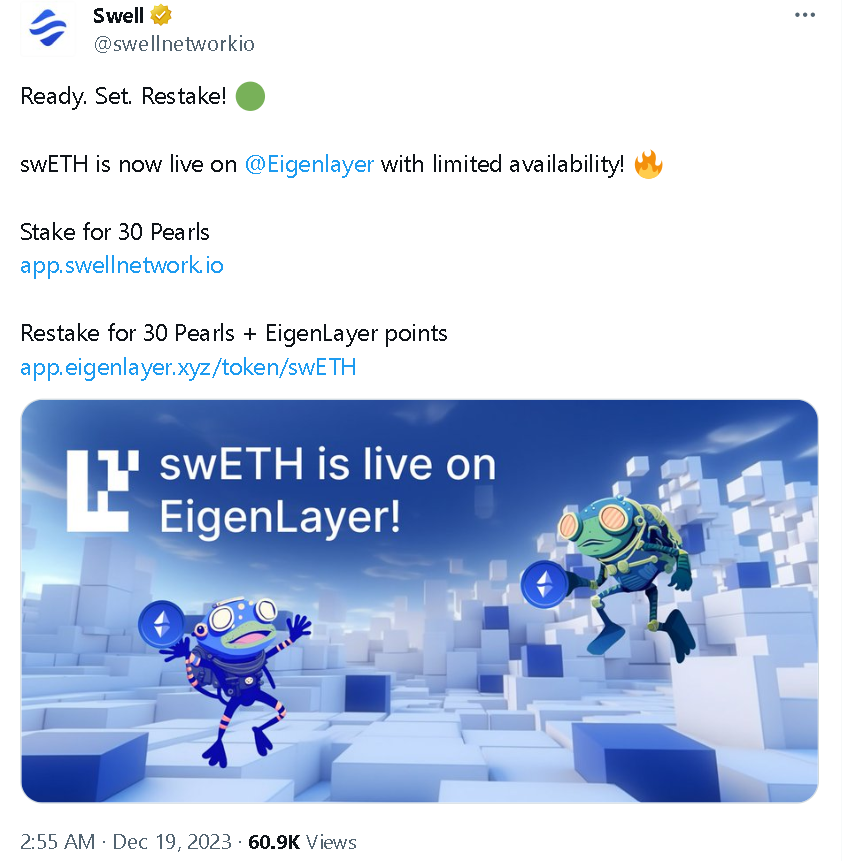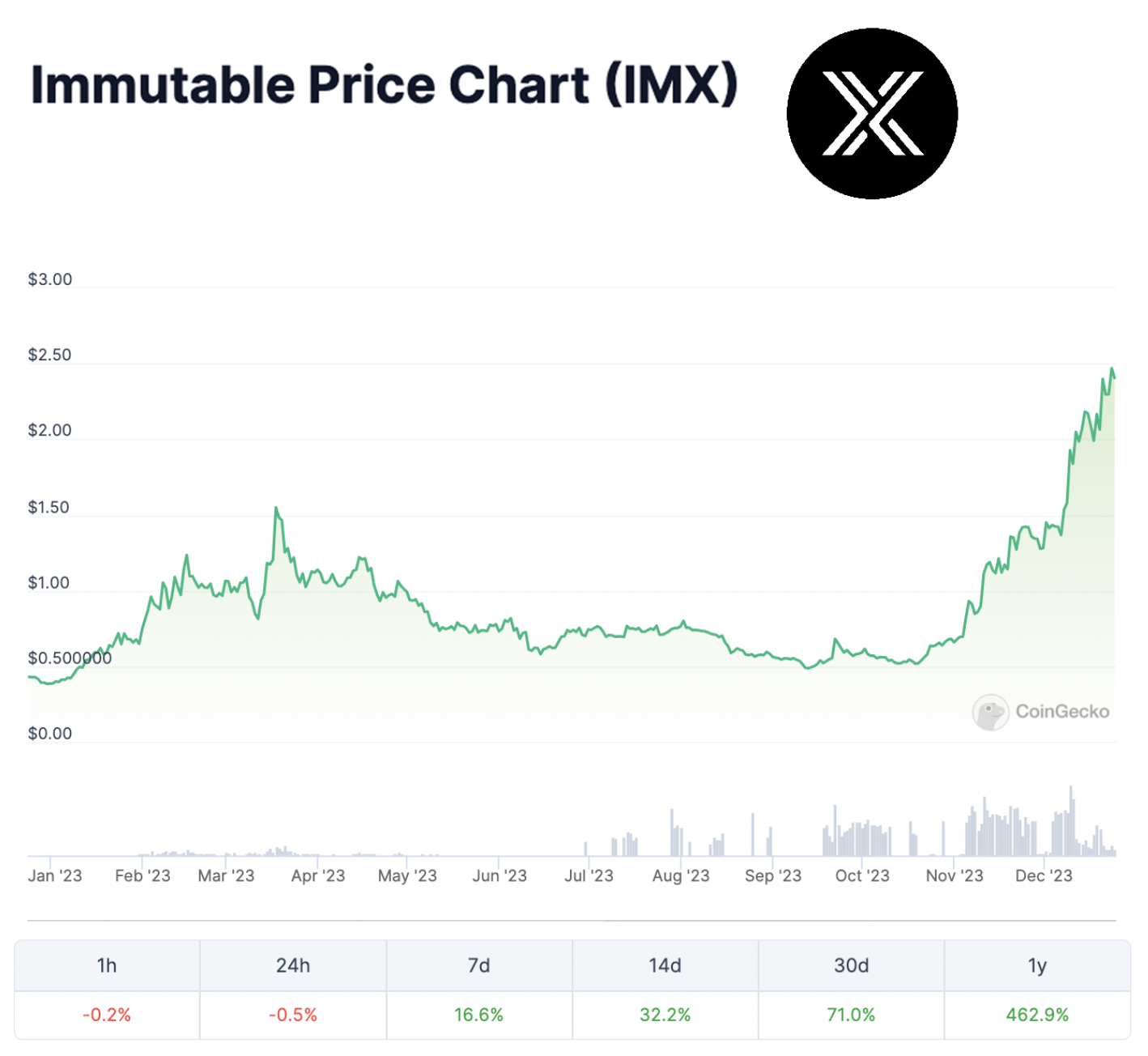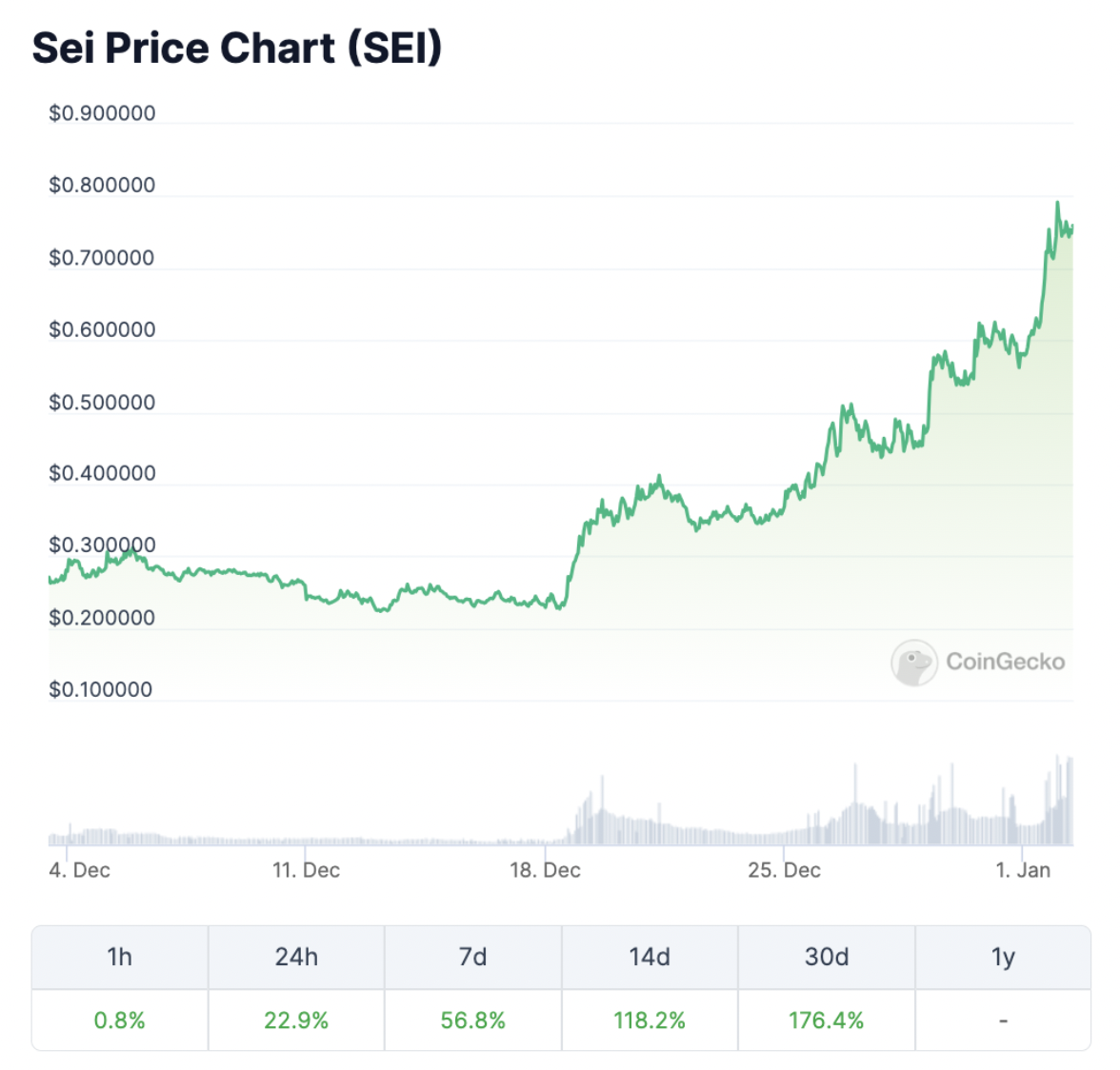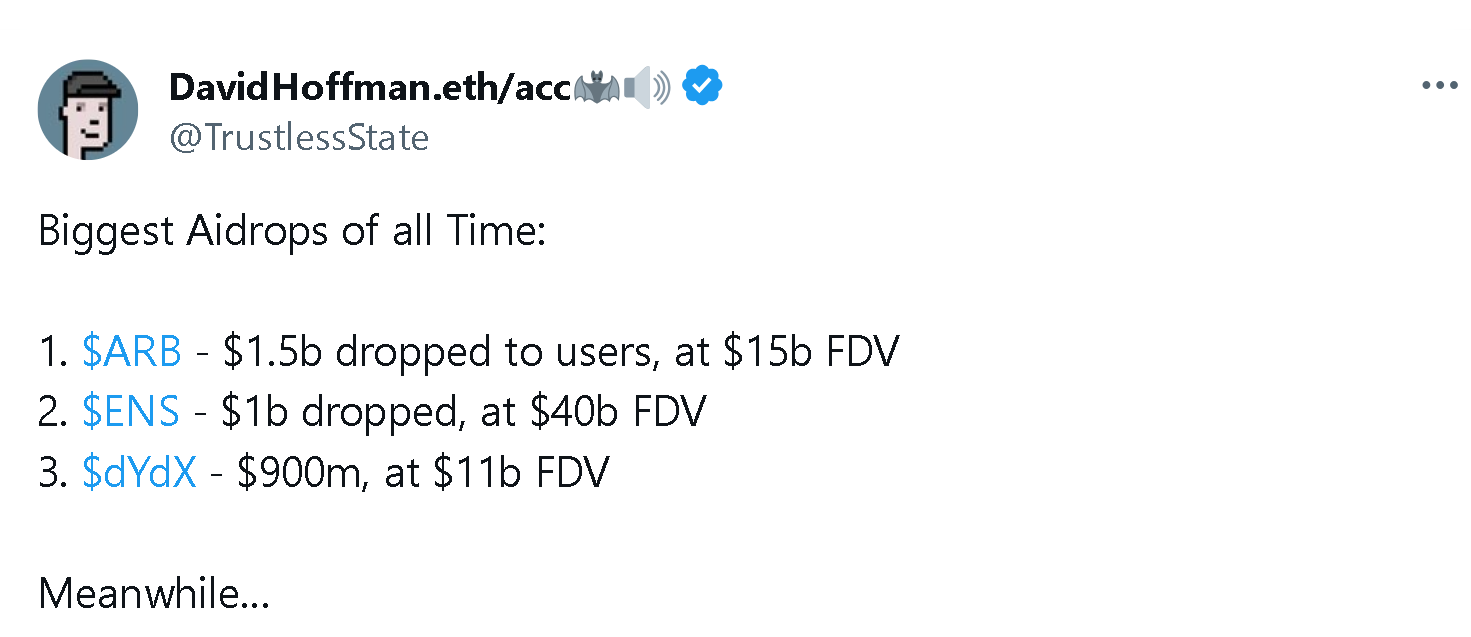The six key crypto themes that Bankless will focus on in 2024: LRT, DA Wars, Parallel EVM
Title: 《2024 Crypto Metas》
Author: David Hoffman
Compiled by: Luccy, BlockBeats
Editor’s Note: David Hoffman, co-owner of Bankless, elaborates on six meta themes worth watching in the 2024 bull market, including Liquidity Re-staked Tokens (LRT), Solana's development, the gaming ecosystem Immutable and its IMX token, DA Wars, Monad's commitment to parallelizing EVM, and retroactive airdrops. The original text is compiled as follows:
At the beginning of 2023, our industry faced some of the most pessimistic sentiments ever, yet it ended with one of the most optimistic patterns we have seen to date.
As we enter the 2024 bull market with renewed vigor, it’s time to focus on some key investment themes that will shape the new year. Stay ahead by understanding these six narrative meta themes that will dominate in the coming months!
Re-staking and Liquidity Re-staked Tokens (LRT)
The meta theme of re-staking is gaining momentum, even before EigenLayer has officially launched. Today, over $1 billion has already been deposited into EigenLayer contracts, and the competition to become a key player in the EigenLayer ecosystem is fierce.
Thus, the Liquidity Staked Token (LST) war is about to reignite, but this time, it will be the LRT war. Liquidity re-staked tokens will have all the yields from native ETH staking as well as additional yields generated by adding re-staking networks. Why would people settle for a 5% LST yield when they can earn more with LRT?
What are LRTs, you ask? They are like LSTs, but their yields include earnings from EigenLayer. EigenLayer supports AVS (Active Validation Services, i.e., the EigenLayer network), which will generate some earnings or fees for those re-staking ETH. Re-stakers may re-stake to multiple AVS to maximize the productivity of their staked ETH and increase yields.
That said, for users like me, who know that others can do better with lower technical skills, developing a service that safely and effectively accomplishes this task will be valuable. This is where LRTs come into play. LRTs aggregate user deposits, re-stake them through the EigenLayer network, capture all yields, and pass them on to depositors.
This is fantastic; however, beyond the basic utility here, I believe one of the reasons for the upcoming LRT boom in 2024 is that the latest wave of airdrop meta themes has already begun. In this massive tide of interest and activity, LRT projects have become a "double whammy," a two-for-one airdrop hunting opportunity. For example, Swell is currently offering their "Pearls," which I believe are placeholders for the eventual Swell token, positioned above EigenLayer points, which I also consider placeholders.

Frankly, I believe EigenLayer is becoming one of the largest airdrops in history, and the competition to become the dominant LRT token in Ethereum will be as fierce as the competition to become the dominant LST token.
Admittedly, I am not familiar with all the LRT strategies of the current teams. Here, I will let you conduct your own due diligence. However, there are two projects I am keeping an eye on because I have close relationships with the teams as an angel investor or through Bankless Ventures; these two projects are Puffer and Swell, as mentioned earlier.
Notably, Puffer has a unique advantage in its collaboration with SGX, which provides an additional layer of cut protection as a defense against capital loss. This mechanism, combined with Puffer's collaboration with Justin Drake on smooth commitments and with Andrew Miller from Flashbots on remote attestation, allows the project to unlock efficiencies and opportunities that other LRTs may need to catch up to.
As for Swell, this is an LST project that pivoted to Liquidity Restake when they saw ominous signs. When EigenLayer opened the deposit gates, Swell was already ahead in the competition. Currently, Swell ranks first among LRT projects in EigenLayer deposits and second in LST deposits, only behind Lido.
However, there are some projects worth watching in the current landscape, including Rio Network, EtherFi, Renzo Protocol, and Kelp DAO.
Solana
Is the current meta theme "Bitcoin, Ethereum… and Solana"?
Solana is currently making a big splash. This happens when a token rises 900% in a year. It has re-attracted venture capital and attention, boosting the confidence of the community that believed in it before.
Certainly, the launch of Jito has just sparked a version of Ethereum's DeFi summer of 2020 on Solana, and it is now clear that the application layer of the network has risen from the ashes of the 2022 to 2023 bear market.
With Solana's SOL just entering the top 5 crypto assets, everyone is watching whether Solana can achieve what all its biggest supporters believe it can: to become the most likely place to host breakthrough consumer crypto applications in the upcoming bull market.
Assuming Solana will realize its potential here, it will need to attract more novel founders who build more innovative applications, rather than just shinier versions of the same things Ethereum already has. Solana will need to develop new types of applications that have never been seen in cryptocurrency, enabled by the unique properties provided by the network.
DePIN seems to be an early standout competitor here. However, I think it’s too early to conclude whether there is any substance here. Nevertheless, we will see that, either way, the industry is worth closely tracking simultaneously.
Meanwhile, a large number of non-token Solana protocols still need to airdrop tokens in 2024, which means that at least until they do, the hype and attention on Solana will continue. Whether the Solana version of DeFi Summer can maintain people's attention after it ends remains to be seen.
Internally, Solana's focus has shifted to its economy. With some of Solana's trickiest issues now in the past, it’s time to turn to the next easiest target in the project, which is its native fee market and overall economic structure. Can Solana solve its economic issues? Only time will tell, but its community is more optimistic about its chances than ever.
Gaming
Gaming seems to be the most reliable category for breakthrough crypto applications in the near future. Mainly because we know that many highly anticipated games are currently in development, with some set to launch in 2024.
If a game is fun, players will play. If game developers know what they are doing, they will cleverly introduce crypto elements as needed, rather than making them overwhelming in the game. The content of games itself is a massive industry, and the distribution that cryptocurrency can gain through the gaming space is also enormous.
One of the best aspects of the contemporary crypto gaming industry is that it is moving away from a clear focus on crypto-native players. Many new games are being developed for those who are agnostic to cryptocurrency.
This shift distances our space from one of the most populous countries on Earth, as there are currently about 3.2 billion gamers worldwide. If we can build a game that appeals to crypto agnostics, it will become the first breakthrough example for cryptocurrency, providing something for those who do not care about crypto.
Meanwhile, look at gaming ecosystems like Immutable and its IMX token as exciting representatives. Immutable is developing a game-specific zkEVM chain built on Polygon, currently valued higher than Arbitrum!

DA Wars
The battle for data availability has also begun, with its start traceable to the TIA airdrop, launching with a $20 billion valuation, followed by a chart rise, with FDV climbing to $14 billion.
So, why is everyone obsessed with data availability now?
That is to say, it can be fairly assumed that DA is like the bandwidth layer of Web3, where a cheap DA layer will transform cryptocurrency from slow and expensive to fast, cheap, and abundant, without sacrificing decentralization in the process. In fact, DA is the main bottleneck that prevents chains from scaling in terms of resource costs and throughput levels. Therefore, any DA chain that can meet these demands will see long-term sustainable value flow in the crypto economy.
I am keeping an eye on the upcoming EigenDA, which is the first AVS launched by EigenLayer, and it will be the first additional source of earnings for the LRT tokens I mentioned earlier.
EigenDA is built differently from Celestia and has some unique network properties. Since EigenDA is secured by staked ETH rather than an alternative L1, this brings EigenDA's DA properties closer to Ethereum, reducing some security assumptions and potentially making it a more accessible choice for Rollups that still require more DA than Ethereum L1 can provide.
Celestia and EigenDA are currently the two main competitors, but others are also joining the DA wars. For example, NEAR has added DA capabilities to its chain, which also has some unique properties due to NEAR's sharding research over the past few years. I am sure there are more that I haven’t heard of yet, or are secret, that will launch in 2024, as the bounty for the DA race is now so large.
Parallel EVM
Solana has sparked the urgency to build optimized virtual machines for Web3. In a recent episode, I asked Solana founder Anatoly Yakovenko, "What is the most critical component of Solana?" He replied, "The parallelization of SVM." This unique property that Solana brings to market is the ability to process multiple transactions simultaneously, as long as those transactions do not touch the same state.
This is a significant advantage of SVM and a major weakness of EVM. Now, the parallel virtual machine war is taking place on Ethereum L2 and new L1s. For example, the Eclipse project is adopting SVM and building an Ethereum-based rollup (using Celestia for DA), and it is not the only project doing so.
Monad is another project that has been dedicated to parallelizing EVM for some time. Rebuilding EVM from single-threaded to multi-threaded is no easy task, but the rewards for successful execution are enormous. Imagine the scale, speed, and cheapness of Solana, but with Ethereum's ecosystem. Monad is committed to achieving bytecode equivalence for EVM, meaning any code written in the EVM environment can be immediately ported to Monad at no cost.
The "speed of Solana and the distribution of Ethereum" strategy is not only recognized by Monad and Eclipse. Sei has also embraced this strategy, as evidenced by their recent announcement of becoming a parallel EVM chain.
Note that since I started writing this article in December, SEI's price has exploded, as the speed of attention on this narrative has exceeded my expectations. Since Monad has not yet launched, SEI is the only easy way to access the parallel EVM narrative, and its token has appreciated accordingly.

While Monad seems intent on remaining a standalone L1, I predict that Monad EVM will become the target for EVM alternatives on Ethereum L2. If Monad open-sources its EVM, it will become a very hot software for Web3. For Monad, pursuing both ETH L2 and a standalone L1 may also be a viable strategy to ensure it fills the competitive landscape as much as possible.
Last November, I had a conversation with Ansgar, in which he expressed interest in finding a new VM specification to design L2, one that optimizes execution better than simply copying L1 EVM as L2. Our thought process was that if we could find a better execution-optimized virtual machine for L2, we could unite L2 to use it as a standard instead of the traditional (and slow) EVM. This shift requires coordination, but it would greatly improve the Ethereum L2 space.
Airdrops
My very safe prediction for 2024 is that $2 billion will be airdropped to users. EigenLayer could even implement this itself.

Airdrops were not new in 2021, but the retroactive Uniswap airdrop did spark a new paradigm for the meaning of airdrops and how applications can leverage them. Fast forward to today, some of the biggest projects in the space have been fine-tuning their token issuance plans for years.
So, now is the time to take action. For example, StarkNet and LayerZero have recently confirmed upcoming tokens, and I expect both to happen in the first quarter of 2024.
These airdrops will also force others to accelerate their token timelines. Once the full momentum of the new airdrop season begins, it’s hard to stop. After all the giants drop their tokens and hand billions of dollars to users, you will see followers quickly develop their "applications" and release their "tokens" to catch this wave.
Once this happens, you will know we are approaching the peak of the bubble, and it’s time to start selling rather than buying. Be careful out there; the traps of airdrop mining may lure most of your funds for yield maximization, but this will happen when you have reasons to withdraw your funds.
For example, Alameda began engaging in zero-risk Bitcoin arbitrage on exchanges, ultimately fully exploiting illiquid junk coins as the bull market progressed. You want to do the opposite. You want to start fully utilizing illiquid junk coins and then sell USD, BTC, ETH, and other safe-haven positions as the bull market progresses.









